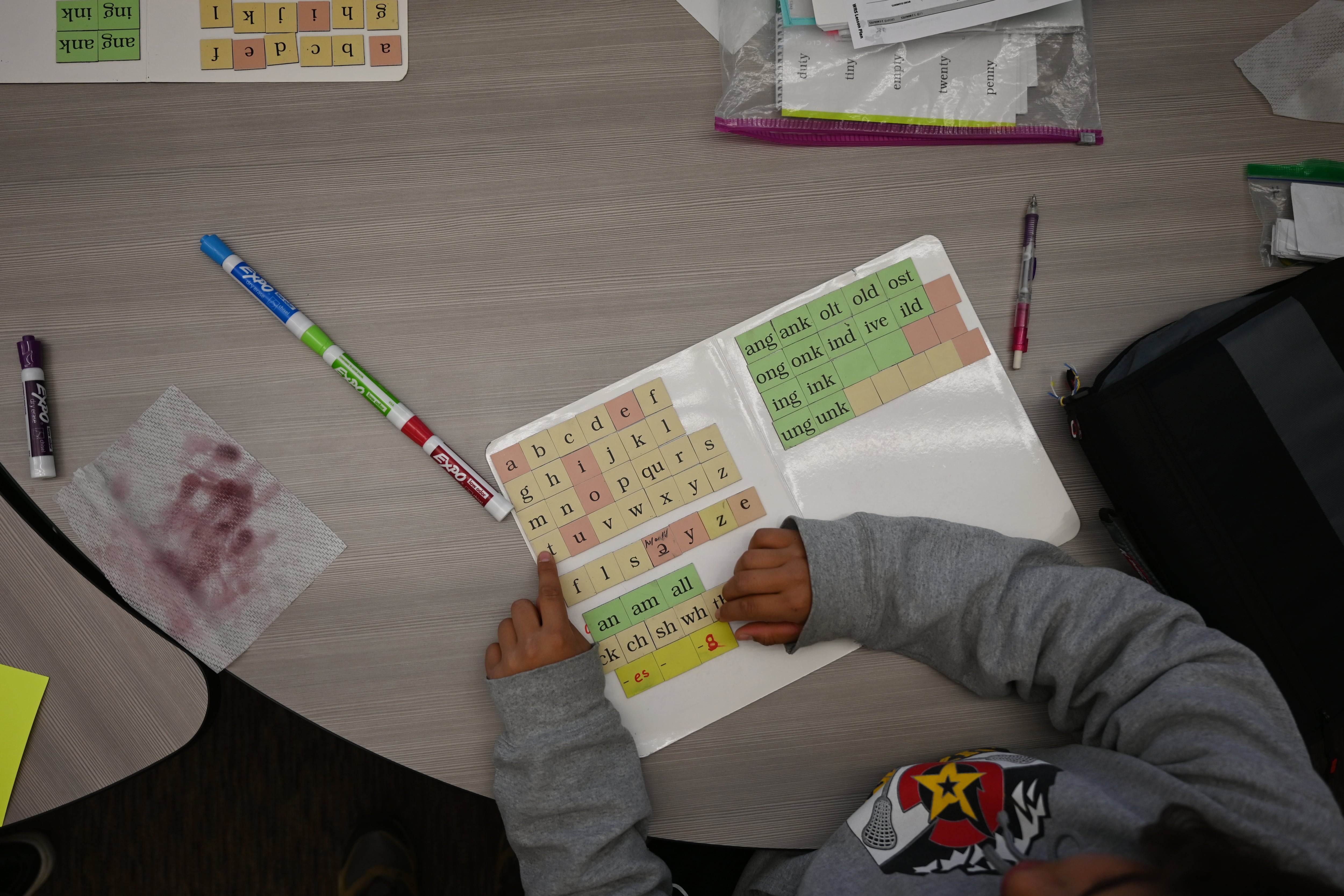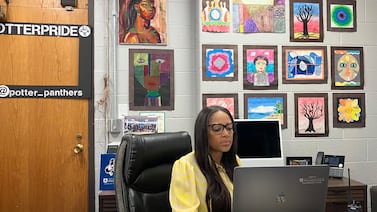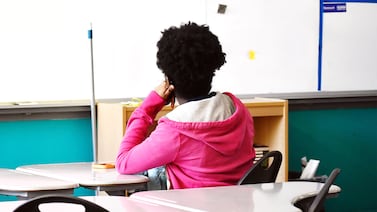Letters seem to move around on the page for Evan Kaganov, but thanks to assistive technology and extra support at school and at home, he now reads well enough to manage all A’s and B’s in eighth grade at Bach Elementary School in Ann Arbor.
Among students with dyslexia in Michigan, Evan is lucky. Many don’t get the same support. That’s one reason why the state’s fourth grade reading scores are among the worst nationwide — and why a bipartisan group of state lawmakers supported a package of bills this year to support students with dyslexia.
But the legislation failed to make it into law, dashing optimism among advocates for students with dyslexia that this was their year.
Now that lawmakers have adjourned the 2021-22 legislative session, it’s back to square one. Democrats could breathe new life into the bill when they take control of the Legislature in January, but the path forward may be complicated by other legislative priorities.
Dyslexia is a common learning disability that affects between 5% and 20% of all people.
Students with dyslexia often struggle to make the connection between letters and sounds, which is a fundamental component of reading. But with high-quality instruction, these students can learn to read effectively, research shows.
Most states have some system in place to promptly identify and support dyslexic students, but Michigan law hardly mentions dyslexia.
The effort to write a comprehensive state policy on dyslexia has moved in fits and starts over the last two years. In May, the bills passed the Senate nearly unanimously in a rare demonstration of broad bipartisanship. The House had seven months to follow suit, but the Education Committee never brought the bills forward.
As the end of the legislative session approached, Gov. Gretchen Whitmer negotiated with GOP leaders over what, if anything, the Legislature would pass during the lame duck session, but little came of it.
The dyslexia package wasn’t a priority in those talks, effectively ensuring that the bills didn’t have a chance to become law, said Rep. Pamela Hornberger, R-Chesterfield Township, chair of the House Education Committee.
“I don’t think it was ever high on anyone’s radar,” she said. “It’s unfortunate. Hopefully it will pass in the next session.”
Proponents of the legislation say Hornberger was distracted by a tight race for state Senate, which she ultimately lost to Democrat Kevin Hertel. Hornberger said House leaders could have simply submitted it to a vote of the full chamber if they thought it had a chance of becoming law.
Advocates frustrated by stalled bills
Democratic state Sen. Jeff Irwin of Ann Arbor and Republican state Rep. Jim Runestad of White Lake — two sponsors of the bills — weren’t ready to give up on their legislation until the legislative session ended last week.
“I’m intensely frustrated that it’s sitting right on the precipice of passing and it isn’t getting done,” Irwin told the Ann Arbor Parent Advisory Council during a Zoom meeting last week.
Susan Schmidt, a retired special education teacher who now tutors children with dyslexia, is frustrated, too. She worked with Irwin and other stakeholders to draft the bill package.
“I’m extremely sad it didn’t pass, because there should be a sense of urgency in this state that we aren’t doing what we need to do to help kids learn to read,” said Schmidt, who recently was elected to the Ann Arbor Board of Education.
Schmidt sees the bills as a means to address more than dyslexia. They would change how reading is taught to all students, she said.
The bills spring out of fierce debates over the best way to teach children to read. In recent years, a consensus has developed among researchers and educators that phonics is an essential component of early literacy instruction, and that some curriculums and teacher training programs have given it short shrift.
Phonetic instruction systematically introduces children to letter sounds. It teaches them to recognize letter patterns, sound out words, and learn general rules such as: In many words ending with E — such as “make” or “pile” — usually the first vowel sound is long and the ending E is silent.
These concepts are particularly helpful to students with dyslexia, though advocates note that they are a fundamental component of literacy and helpful to all early readers.
There is no research on how much Michigan schools focus on phonics in literacy instruction, or what reading curriculums they use.
While many districts use effective curriculums that focus on phonics — notably the Detroit Public Schools Community District, which overhauled its literacy curriculum over the last five years — advocates say some districts are still using what’s called a “balanced literacy” approach.
That approach, which is also called “whole language,” relies on word repetition, teaches children to memorize “sight words,” and encourages them to figure out words based on context and images.
It didn’t work for Evan, said his mother, Caroline Kaganov.
“We shouldn’t be teaching kids how to guess. We should be teaching them how to use the English language, look at syllables, break down syllables … and figure out how vowels work together,” she said.
Schmidt also wants schools to return to phonics-based reading instruction.
“By teaching children how the English language is linguistically put together, you’re giving them the framework,” Schmidt said. “Forty percent, we know, are going to learn to read no matter what. For the 60% that need to … learn the code to read, this is very important to them.”
That’s especially true for children with dyslexia, Schmidt said.
Still some teachers are resistant, she said.
“Imagine you’ve done it one way for 20 years, and somebody comes along and says do something different,” she said. But, she said, “There’s also a whole lot of teachers that are like, ‘Oh, you have some ideas. I have some kids I don’t know how to reach,’ and they’re totally geeked.”
Dyslexia support: How interventions help readers
Evan was diagnosed with severe dyslexia in first grade, but only after his mother argued with district administrators, contacted a lawyer, and arranged for an independent evaluation so he could qualify for extra help. Now he gets a head start at home on in-class reading assignments, uses a computer program that reads along with him while highlighting words as it goes, and writes papers using a voice-to-text program.
Evan still reads much slower than his peers — 114 words per minute compared with the average of 153 for his grade level. But he now has the accommodations he needs to keep up in class.
Evan’s dyslexia was so severe that it was bound to be identified sooner or later, but children with less obvious signs of the condition might miss out on extra help they need, Kaganov said.
“My kid is severely dyslexic and I had to fight for intervention,” she said. “What about those kids who are just slightly dyslexic? They should have a right to attain literacy, too. I’m worried about those kids.”
Universal screening would ensure all children get the help they need, she said.
Here are key components of the legislation:
- Requires districts to screen all K-3 students for dyslexia. Many would be able to use tests students already take.
- Requires districts to provide specialized instruction to children who show signs of dyslexia.
- Mandates training on dyslexia education for teachers working with young readers.
- Requires teacher preparation programs to offer instruction specific to dyslexia. (Several programs previously told Chalkbeat they already meet this requirement.)
Some experts, including Rachael Gabriel, an education professor at the University of Connecticut, have cautioned that tests that screen for dyslexia aren’t reliable and that similar legislation in other states has been less effective than advocates hoped.
Other experts testified in favor of the bills, including Detroit Superintendent Nikolai Vitti and David Winters, head of the department of special education and communications sciences and disorders at Eastern Michigan University.
The bills could lead to higher costs for Michigan schools if they result in more students being identified for special education services. Schools are required to support students with disabilities, and financial analysts noted that the measures could save money in the long run if they decrease the number of people who need extra help in school and beyond because they struggle to read.
Bills face an uncertain path forward
After bipartisan shows of support for the bills, advocates believe they can pass a Legislature reconfigured by big wins for Democrats in November.
But while many Democrats support the dyslexia bills, they are more focused on a different reading reform. They want to repeal a portion of Michigan’s third grade reading law that requires districts to hold back third graders who are more than one grade level behind in reading.
While most struggling readers have been exempted from retention under the law, Black students are twice as likely to be retained. Democrats, including Whitmer, have made repealing it a priority.
Attaching the dyslexia bills to third grade reading reforms might help move the bills quickly through the legislature, or it might add a layer of complexity to already knotty debates over retention and literacy.
“Complication often leads to delay,” Irwin said. “I was hoping we could get (the dyslexia bills) moving and then have a separate discussion about how to right-size the Read by Grade 3 law.”
Despite bipartisan support for the dyslexia bills, some administrators have reservations. Notably, leaders of teachers colleges have argued that they already cover the basics of dyslexia with future teachers, and say they don’t need another mandate from Lansing.
Still, teachers unions — a key part of the Democratic coalition — support the bills.
“We think it would be great to have more training to recognize dyslexia in students so they can get the help they need,” said Thomas Morgan, spokesman for the Michigan Education Association.
Unions would like to see changes to the bills to ensure teachers are given the time to meet the demands of learning new teaching methods and providing extra support to poor readers.
“We’re already pretty overstretched,” said Janell Mansfield, political and legislative coordinator for the Michigan branch of the American Federation of Teachers.
But she added that a lot of teachers see phonics as an answer to Michigan’s sinking test scores.
“I definitely don’t think it’s too burdensome to ask teachers to do continuing education to learn how to support students with dyslexia,” she said.
Tracie Mauriello writes about state education policy for Chalkbeat Detroit and Bridge Michigan. Reach her at tmauriello@chalkbeat.org.
Koby Levin is a reporter for Chalkbeat Detroit covering K-12 schools and early childhood education. Contact Koby at klevin@chalkbeat.org.







